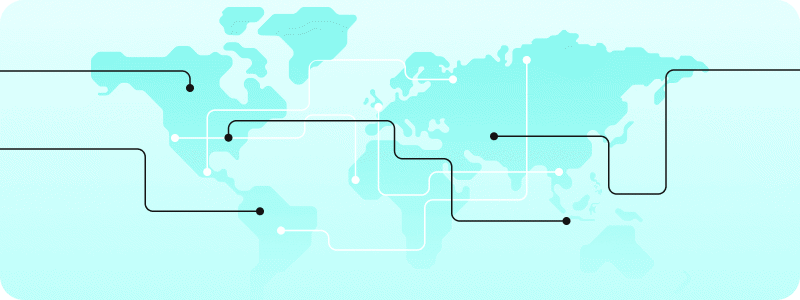Shopify Plus Playbook
Cross-Border Commerce
Welcome to the ultimate guide to cross-border commerce, brought to you by Loqate in collaboration with some of the biggest Shopify partners in the industry.
In an era where ecommerce knows no borders, tapping into international markets is no longer just an option but a necessity for sustainable growth and success.
Introduction
Welcome to the ultimate guide to cross-border commerce, brought to you by Loqate in collaboration with some of the biggest Shopify partners in the industry.
In an era where ecommerce knows no borders, tapping into international markets is no longer just an option but a necessity for sustainable growth and success. However, navigating the complexities of cross-border commerce can be challenging and even the biggest brands can get it wrong.
That’s why we’ve teamed up with Shopify’s leading experts such as Avalara, ShipBob, and Vervaunt to provide you with invaluable insights, expert advice, and practical strategies for navigating the complexities of cross-border commerce. Whether you're just starting out or looking to optimize your existing cross-border operations, this guide has everything you need to thrive in the international marketplace.
From understanding the nuances of international taxes and compliance to optimizing your logistics and fulfillment processes, our partners will share their expertize and best practices to help you overcome common challenges and capitalize on lucrative opportunities in global markets.
Get ready to unlock the full potential of cross-border commerce and take your Shopify Plus store to new heights.
Navigating international fulfilment

Retailers expanding globally must carefully consider where they will fulfill and ship their international orders from. There is no one-size-fits-all solution, but retailers should assess their specific situation to determine the right strategy.
The cost of shipping internationally can be prohibitive, and the added expenses of duties, taxes, and compliance can put cross-border shipping at a disadvantage. This is particularly true for lower-value products that exceed the 2.0 KG threshold to qualify for postal shipments.
However, several factors can make cross-border shipping very attractive, such as a high duty-free threshold (i.e. de minimis) at the destination, low-cost shipping options from lower-tier postal services which pay less for global shipping, and the availability and simplicity of service providers and customs at either the origin or destination.
Once a retailer goes international, it should consider not only its outbound fulfillment and shipping needs but also factor in its supply chain and the carrying cost of inventory.
A fast-moving, high-turnover product may opt for a streamlined supply chain and logistics, while a more stable SKU base that moves more slowly may benefit from a traditional setup.
It is common for brands to have multiple fulfillment centers around the world to meet their specific needs. Popular regional centers for fulfillment and shipping include Shenzhen, Hong Kong, Singapore, Amsterdam, and Brussels. Markets like the GCC/MENA are often thought of as a cluster. And some markets are considered islands, like ANZ, India, and domestic China.
Overcoming the complexities of tax compliance

As you expand, your international compliance obligations grow with you. They can be complicated and time-consuming.
But scalable, automated solutions that integrate into your existing systems can help. They can free you from distracting manual tasks, spare you the disruption of upgrading your systems for each new market you enter, and help ensure borders don’t become barriers.
Move quickly through customs and delight overseas customers
Without the correct HS codes — which allow customs authorities to apply the right duties and taxes to your shipments — your goods could be held up in customs, and surprise fees could be passed onto the buyer. And because the codes update every few years, and the same products could have different codes in different regions, mistakes are easily made. Automating the assignment of HS codes can help move your goods through customs as quickly as possible and keep your customers happy with timely deliveries.
Identify where you have tax obligations
Knowing where you need to pay tax and how much you owe can be difficult to determine, especially in overseas markets. In the U.S. for example, there are over 13,000 sales and tax jurisdictions with different rates and rules. Trying to work things out manually is near impossible. Automation can alert you when you’re approaching thresholds or have triggered new obligations, and help you determine what you owe.
Building an international loyalty program
Shopify Plus merchants can expand globally by localizing the customer experience with multi-currency and multi-language capabilities.
Additionally, you can incentivize your new global customers to engage and make purchases from your site by integrating a loyalty program. It's easier to optimize a loyalty program for a global audience by implementing tiered rewards structures and personalized offers and using Shopify's analytics to understand regional preferences. It also enables merchants to adjust their ecommerce strategies accordingly.
To promote a program effectively, utilize Shopify's marketing tools and other integrations - such as email campaigns and social media. With Shopify Plus, a scalable loyalty program can be created that drives customer retention and growth across diverse markets.
Localize your fulfilment strategy

Following your customers’ shipping destination data can be very revealing to see where demand is coming from. If you’re already shipping orders internationally to certain countries, there may come a point for you to start fulfilling those orders domestically.
ShipBob’s 2024 State of Ecommerce Fulfillment Report found that 36% of ecommerce brands plan to either ship to new countries in 2024 or fulfill orders in new countries, with 21% planning to start physically fulfilling orders in new countries in 2024.
The ability to store inventory in more than one country for a localized approach to order fulfillment can greatly reduce shipping costs and transit times for customers in those countries.
And this strategy may be easier to execute on than you think – by partnering with a fulfillment company that has a footprint across the key markets/countries you want to sell in, global expansion can be quite seamless.
However, you must first determine whether your products can be sold and shipped locally. Once that is confirmed, you can research the various business requirements for legal and tax purposes to understand how to get started in each specific country.
ShipBob lists these for each country in which we have a fulfilment center:
- To sell within the US, you need an Employer Identification Number (EIN), and an LLC registration is recommended.
- To sell within the UK, you need unique Value-Added Tax (VAT) and/or Economic Operators Registration and Identification (EORI) registration numbers.
- To sell within the EU, you need unique VAT, EORI, and Union One-Stop Shop (OSS) registration numbers.
- To sell in Australia, you need an Australia Business Number (ABN) and Goods and Services Tax (GST) registration.
- To sell in Canada, you need to register for your Goods and Services Tax (GST) and Non-Resident Importer (NRI).
As time goes on, you’ll want to continue to follow this data to both get started in new countries and optimize the countries you’re already fulfilling in.
Localising the post-purchase experience
Platforms like Shopify have changed the game for ecommerce, giving brands of all sizes a chance to shine globally. This means that online stores can now easily expand their reach across borders, connecting with customers wherever they are.
At Penny Black, we empower brands to build connections with their customers and drive repeat purchases. Through personalized inserts, we transform the unboxing experience into a high-converting marketing channel that outperforms traditional post-purchase emails fivefold.
And, while many brands recognize the importance of adding value to their packages, they’re unsure how to localise inserts without it becoming a logistical nightmare. That’s where Penny Black comes in. We streamline the process, allowing brands to tailor inserts based on their customers’ location and language preferences.
Take PAUL VALENTINE, a jewellery brand from Germany, for example. They use Penny Black to send their new customers an insert that temps them to shop again with an exclusive discount. With the Penny Black platform, they automate the process and make sure every package gets the right insert, no matter its destination.

Similarly, Yepoda, a Korean skincare brand, uses Penny Black to send personaliszed inserts depending on where their customers are. It's a smart move that lets them speak directly to their audience in their native language, motivating better results.

If you're looking to grow internationally, don't overlook the importance of localizing the post-purchase experience.
This isn’t just about online interactions either – the unboxing moment matters too. With Penny Black, you can make sure your customers feel the love, no matter where they unpack your products.
Using market research to drive ecommerce internationalization

When global growth is your goal, it can be easy to focus on the practical, and perhaps more ‘exciting’, steps you need to take and overlook the importance of market research. Having supported numerous global brands in my role at Swanky, it’s clear that finding success in a new market requires some solid groundwork. Without this foundation to work from, growth can be slow and stagnant.
Thorough market research helps you build a detailed understanding of the differences between regions. You can then adapt your product offering, marketing plan and overall strategy accordingly.
Research will differ from brand to brand, but consider exploring questions such as:
- What are customers looking for in this country or region?
- Which of your USPs resonate best with this audience?
- How do search terms vary across regions?
The answers to questions like these should guide both your planning and implementation stages. It’s easy to assume that if your product is selling well in Germany, for example, it would also sell well in neighbouring Switzerland. This could be true, but don’t allow assumptions to guide your business plan. Instead, do your research and allow this to dictate your globalization roadmap.
Ultimately, if you want to execute an internationalization plan that delivers increased brand awareness and revenue growth in multiple countries, you have to start with thorough market research.
Run a proof of concept

I think it varies massively depending on goals and also why you’re entering the market (e.g. lack of competition, low barriers to entry, existing demand, other channels etc), but my main recommendation would usually be to run POC activity before going all in and investing significant budget - so being able to ship to the given market (competitively), allowing for key payment methods, ensure key on-site messaging is localized etc.
We usually recommend using any existing data (or third party data) you might have to identify a city or two are as a key starting point. This could be search volume by city or customer city data if you have it, if not look for other data points to suggest where your customer may be most densely populated. Are there brands that closely align with your target customer in a country? Where do they have store locations for example. You can then run activity at a smaller scale in this key city before trying to start scaling across the rest of the country. Once you have a baseline level of awareness you can start to re-market at a national level and begin to layer in your retention strategy.
Many of our clients also invest in retail activations, offline campaigns or partnership activity alongside this and then look to amplify. We’d also recommend getting localized retention activity in place, alongside the fundamentals for other channels like organic search.
Understand Cultural Nuances and Context

Understanding cultural nuances is key to global expansion. It involves researching cultural norms, preferences, and sensitivities of your target regions. Aspects like language variations, dialects, and idioms can affect content perception. Collaborating with translators or localization experts who understand the target culture ensures accurate translations.
Adapting visuals, imagery, and design elements to meet cultural preferences is also crucial.
Colors and symbols can have different meanings across cultures, so avoiding misinterpretation is important. Paying attention to cultural nuances in translation creates an engaging experience for international audiences, enhancing user satisfaction and fostering trust. Remember, effective international expansion goes beyond language - it's about cultural connection.
Navigating global addressing
One of the primary challenges businesses face when going global is navigating the intricacies of international data. International addresses vary significantly from country to country, with differences in formatting, language, and postal code systems. This diversity can make it challenging to standardize address input and validation processes, leading to errors, delays, and frustrated customers.
For example, in France, the postal code comes before the city while in Canada it’s the opposite. And in Norway, an address only has two lines. Additionally, nuances like building numbers, unit numbers, or district names can vary significantly from region to region and must be captured correctly for successful delivery.
Language barriers can further complicate international addressing. Non-Latin character sets and different language scripts can pose challenges for address validation systems that are primarily designed for English addresses.
Address verification solutions like Loqate can help mitigate these challenges.
By integrating such tools into your Shopify Plus store, you can validate addresses in real-time, reducing the risk of delivery errors and returned packages. Loqate supports multiple languages and character sets, ensuring accurate validation regardless of the language used.
















